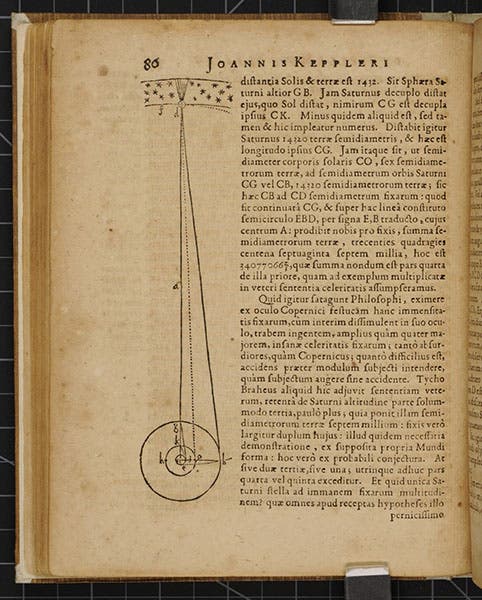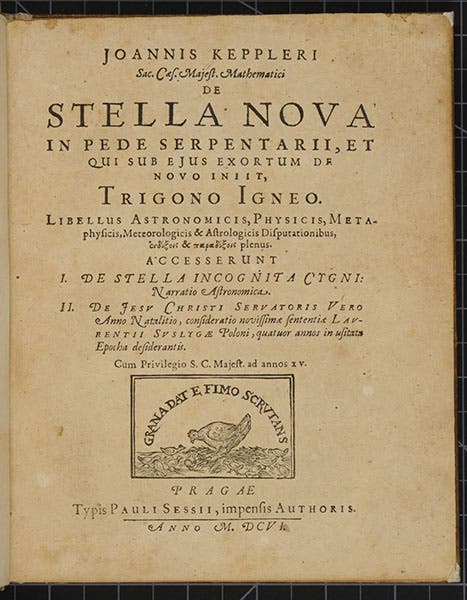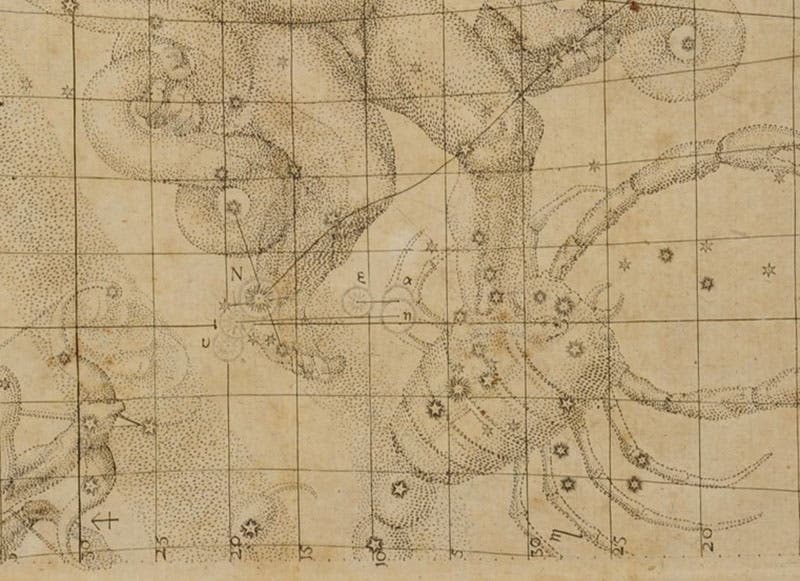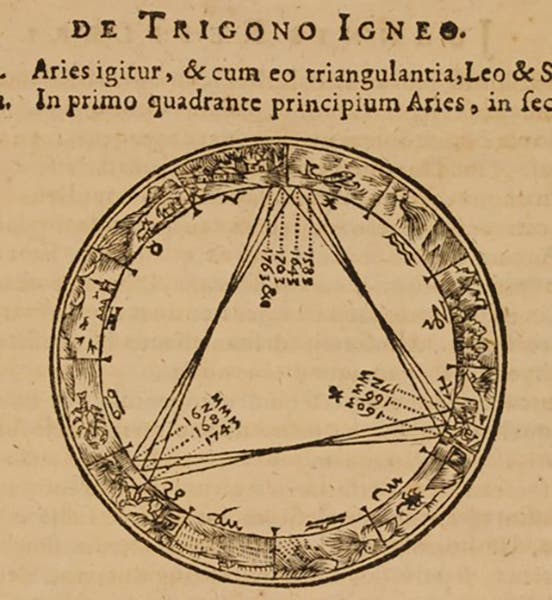Scientist of the Day - Johannes Kepler
On the night of Oct. 17/18, 1604, Johannes Kepler was viewing a triple conjunction of Mars, Jupiter, and Saturn, when he got his first glimpse of a nova, a new star. He did not discover the nova – it had first been glimpsed several days earlier – and it was not an unprecedented event, as there had been novae in 1572, 1596, and 1600. But Kepler’s name would get attached to this one, for several reasons. First, the star would grow in brightness until it was so powerful that it could be seen with the naked eye in the daytime. We now recognize it as a supernova, a term not used until the twentieth century. There has been no supernova like it since the nova of 1604, and it is referred to by astronomers as Kepler’s nova, or SN 1604.
Second, Kepler carefully measured the distance of the nova from half-a-dozen nearby stars, and would continue to do so for the course of an entire year, and he found that the nova did not shift even a minute of arc in its position (astronomers would say it exhibited no parallax, or shift in position), and that therefore it really was a star, out there with all the other stars, and not some nearby phenomenon. Aristotle had maintained that the heavens are immutable and do not change. Tycho Brahe had first argued against this Aristotelian doctrine, when he measured the position of the nova of 1572 (Tycho’s nova) and found that it exhibited no detectable parallax. So Kepler found new evidence to affirm Tycho’s conclusion.
Third, Kepler wrote and published a book about the new star. He called it De stella nova in pede serpentarii (The new star in the foot of Serpentarius, Kepler’s name for the constellation we now call Ophiuchus). The book contained a star map of Serpentarius and the surrounding constellations, which we reproduce here (first image). Several planets are labelled, as you can see in a detail (third image). Between the two feet of Serpentarius, the labels alpha (α) and eta (η) indicate the positions of Saturn and Jupiter, as they were seen on Dec. 17, 1603. The two are quite close together, in conjunction. This event, known as a Great Conjunction, was especially noteworthy for astrologers, as Jupiter and Saturn come into conjunction only once every twenty years. And it was why astronomers were looking so carefully at this part of the sky, and discovered the nova.

A diagram showing that, if the Earth orbits the Sun (bottom), then the stars at top should exhibit parallax, a shift in apparent position, as the Earth moves, unless they are very, very far away. The Nova of 1604 is indicated at top as an explosion. In Johannes Kepler, De stella nova, 1606 (Linda Hall Library)
In the right foot of Serpentarius, there are a cluster of objects. Iota (ι) and mu (μ) indicate the positions of Jupiter and Mars on Oct. 10, 1604 (Saturn on that date is marked by epsilon (ε); it hasn’t moved as far as Jupiter, but it is still close enough to be part of a triple conjunction of three planets). And the nova is labelled N. Note the lines that connect it to nearby stars; these distances are what Kepler measured over time, finding that they did not change. Kepler also included a diagram showing that, since the nova exhibited no parallax, it must be out with the stars (fourth image; the nova is depicted as a flashlight-like object among the stars).
One of the other matters Kepler discussed in De stella nova was the Fiery Trigon (in fact, the term is the last word of the full title of the book). For the previous two hundred years, Great Conjunctions of Jupiter and Saturn had always occurred, 20 years apart, in the zodiacal constellations of Cancer, Scorpio, or Pisces, which lie 120° apart in the heavens, and form a group known to astrologers as the Watery Trigon. The Great Conjunction of 1603 was the first to occur in Sagittarius, which is one of the constellations in the Fiery Trigon, along with Aries and Leo. The rarity of this transition made it of great concern to astrologers, as did the fact that Christ was born at the beginning of a Fiery Trigon cycle, and Charlemagne had restored the Holy Roman Empire at the beginning of the next Fiery Trigon cycle. Kepler discussed its possible significance at length in his treatise. He even included a diagram of how the Great Conjunctions, if mapped onto the Zodiac, form a slowly rotating triangle, which has now moved from the Watery Trigon to the Fiery Trigon (fifth image). It shows the successive conjunctions up until 1763, all in the Fiery Trigon.
Kepler conceded that the Nova of 1604 and the Great Conjunction of 1603 probably had some divine significance, but he generally rejected all the astrological connotations seen by others, such as that the events foretold the Second Coming and the end of the world. Kepler was not opposed to general astrology, but he had little use for judicial astrology, even though he had to cast horoscopes for his patron, Emperor Rudolph II.
We bought our copy of De nova stella at the Honeyman auctions in 1980. There is an article about our acquisitions at the Honeyman sales in the current issue of the Hedgehog, the Library’s house magazine. It is brand new and has not yet been placed online; when it is, you will find it at the top of this list, Number 67, Fall 2021.
We have written two other posts on Kepler; one on his first book, the Cosmographic Mysteries (1596), and another on his foray into allegory with the frontispiece to his Rudolphine Tables (1627). We have yet to compose a post on his discovery that the planets move in elliptical rather than circular orbits, announced in his New Astronomy (1609). Perhaps we shall do so on his next birthday anniversary, Dec. 17.
The best portrait of Kepler, painted in 1612, is reproduced in our post on the Cosmographic Mysteries. For today’s post, we include a rather good likeness that appeared on a postage stamp, issued by the German Democratic Republic in 1971, the 400th anniversary of Kepler’s birth.
Dr. William B. Ashworth, Jr., Consultant for the History of Science, Linda Hall Library and Associate Professor emeritus, Department of History, University of Missouri-Kansas City. Comments or corrections are welcome; please direct to ashworthw@umkc.edu.










